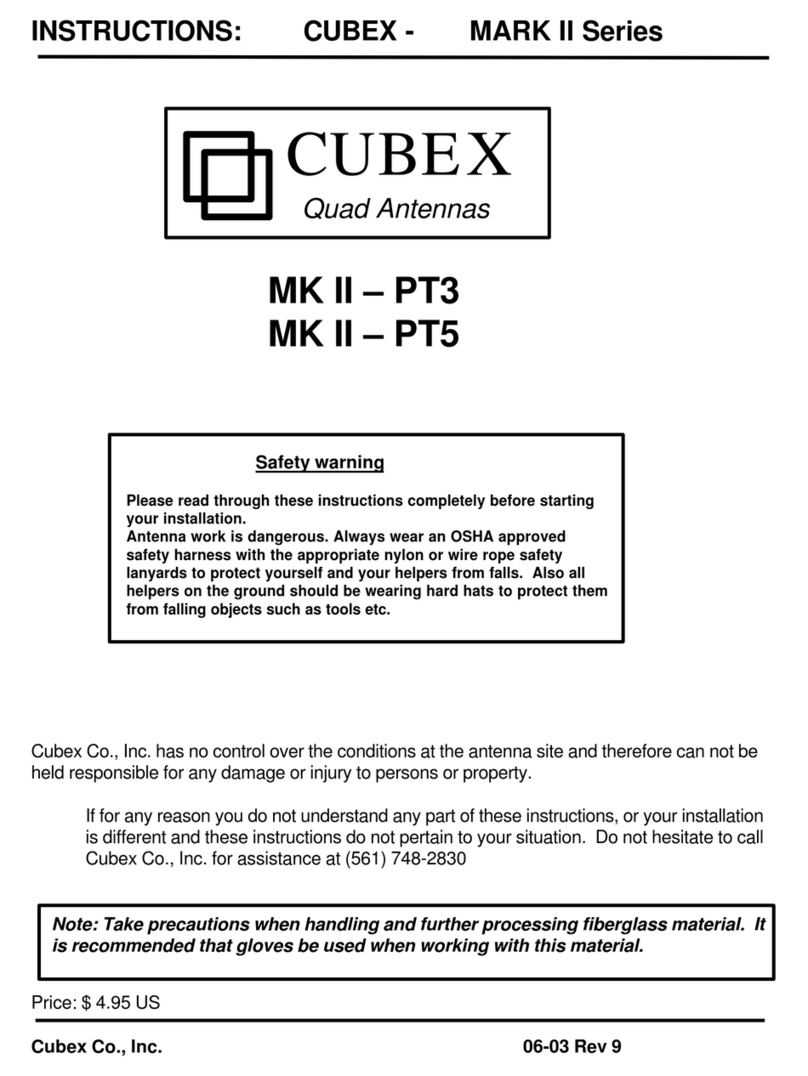
Instructions: Cubex SkyMaster Series
Cubex Co., Inc. 05-06 Rev 0
Pg. 6
18 ft Boom End (start) + 10 ft 18 ft
10.The next step is to attach the 5/16” truss guying Dacron to the two Boom “Eye-Bolts”
and dress the rope through the element array and secure to the two “S” hooks that
make up the Mast support assembly (2” U-Bolt, plates and S hooks) that is installed on
the top of the mast and put a slight upward tension on the boom using a truckers knot to
gain a mechanical advantage. Final tensioning can be made by sliding the u-bolt along
the mast then tighten securely!
Assembly of the Boom to the Mast
11. These directions are a general outline only and your installation may be different. For
instance you may have a tilt over tower and this would make the installation process
different and easier. Feel free to modify these instructions to meet your individual
needs.
Place the BOOM/MAST COUPLER plate at the center of the boom (for improved clearance
offset from center 6 inches toward the Reflector). Fasten the mast plate to the boom using the
supplied bolts. 3” OD boom requiring 4 - 3”x3/8” U-bolts. All U-bolts are secured using, nuts
and lock washers. The bolts should be tightened on the boom sufficiently to preventing
rotation of either with respect to the other. One should keep in mind that as the mast length is
increased the matter of side loading on the rotor increases. Also, if longer lengths are to be
used, the wall thickness of the material should be sufficient to withstand the greater side
loading effects. When the rotor is placed inside a tower, lengths of 10 feet can be used
without trouble as the side loading is absorbed by a tower bearing sleeve. As an aid to lifting
the array, an 8 to 10 foot pole or pipe section (GIN POLE) may be temporarily slipped into the
mast and secured. The Gin Pole is a pole or pipe that has a small pulley at the top. Using a
strong rope the antenna can be pulled up to the final mounting position by an assistant with
little danger to the tower climber. This will usually facilitate getting the array up to the top of
tower, mast, etc.
The antenna array is then lifted into place on the tower and the boom/mast coupler plate is
secured to the mast using the supplied hardware. The antenna & boom assembly is bolted to
the mast using the supplied 3”, “U “bolts REMINDER: DON’T TAKE CHANCES. USE A
CLIMBING BELT OR SAFETY HARNESS WHILE ON A TOWER. THE LIFE YOU SAVE
COULD BE YOURS!
CAUTION; While every effort has been made in designing and fabricating both
the spreader arms and the spiders for maximum strength, it is possible to suffer
breakage if the assembly is dropped or impacted against buildings, trees, etc.,
Use care in handling.
Position the boom to achieve adequate tower clearance while still maintain
a reasonable balance of support by the boom to mast plate. Take time to
sight the arms and adjust to obtain alignment.
12. FEEDING THE, 3 ELEMENT QUAD. The feed-point impedance’s of this antenna
will vary with each band. Twenty meters is about 50 ohms, Fifteen meters about 75 ohms
and Ten meters is about 110 ohms. The CUBEX matching transformer is a combination




























